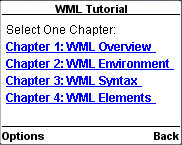
- WML - Home
- WML - Overview
- WML - Environment
- WML - Syntax
- WML - Elements
- WML - Comments
- WML - Variables
- WML - Formatting
- WML - Fonts
- WML - Images
- WML - Tables
- WML - Links
- WML - Tasks
- WML - Inputs
- WML - Submit Data
- WML - Server Scripts
- WML - Events
- WML - Timer
- WML - Template
- WML - DTD
- WML2 - Tutorial
- WML Tools
- WAP - Emulators
- WML - Validator
- WML Useful Resources
- WML - Quick Guide
- WML - Useful Resources
- WML - Discussion
WML - Template
The <template> is used to apply <do> and <onevent> elements to all cards in a deck. This element defines a template for all the cards in a deck and the code in the <template> tag is added to each card in the deck.
You can override a <do> element of a template by defining another <do> element with the same name attribute value in a WML card.
The <template> element supports the following attributes:
| Attribute | Value | Description |
|---|---|---|
| onenterbackward | URL | Occurs when the user navigates into a card using a "prev" task |
| onenterforward | URL | Occurs when the user navigates into a card using a "go" task |
| ontimer | URL | Occurs when the "timer" expires |
| class | class data | Sets a class name for the element. |
| id | element ID | A unique ID for the element. |
Following is the example showing usage of <go> element.
<?xml version="1.0"?>
<!DOCTYPE wml PUBLIC "-//WAPFORUM//DTD WML 1.3//EN"
"http://www.wapforum.org/DTD/wml13.dtd">
<wml>
<template>
<do name="main_menu" type="accept" label="Chapters">
<go href="chapters"/>
</do>
<do name="menu_1" type="accept" label="Chapter 1">
<go href="#chapter1"/>
</do>
<do name="menu_2" type="accept" label="Chapter 2">
<go href="#chapter2"/>
</do>
<do name="menu_3" type="accept" label="Chapter 3">
<go href="#chapter3"/>
</do>
<do name="menu_4" type="accept" label="Chapter 4">
<go href="#chapter4"/>
</do>
</template>
<card id="chapters" title="WML Tutorial">
<p>
Select One Chapter:<br/>
<anchor>
<go href="#chapter1"/>
Chapter 1: WML Overview
</anchor><br />
<anchor>
<go href="#chapter2"/>
Chapter 2: WML Environment
</anchor><br />
<anchor>
<go href="#chapter3"/>
Chapter 3: WML Syntax
</anchor><br />
<anchor>
<go href="#chapter4"/>
Chapter 4: WML Elements
</anchor><br />
</p>
</card>
<card id="chapter1" title="WML Tutorial Ch1">
<p>
<em>Chapter 1: WML Introduction</em><br/>
...
</p>
</card>
<card id="chapter2" title="WML Tutorial Ch2">
<p>
<em>Chapter 2: WML Environment</em><br/>
...
</p>
</card>
<card id="chapter3" title="WML Tutorial Ch3">
<p>
<em>Chapter 3: WML Syntax</em><br/>
...
</p>
</card>
<card id="chapter4" title="WML Tutorial Ch4">
<p>
<em>Chapter 4: WML Elements</em><br/>
...
</p>
</card>
</wml>
This will produce the following menu and now you can navigate through all the chapters:

Advertisements